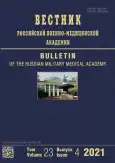Berylliosis
- Authors: Khalimov Y.S.1, Tsepkova G.A.1, Vlasenko A.N.1
-
Affiliations:
- Military Medical Academy named after S.M. Kirov of the Ministry of Defense of the Russian Federation
- Issue: Vol 23, No 4 (2021)
- Pages: 265-272
- Section: Reviews
- URL: https://journals.rcsi.science/1682-7392/article/view/66441
- DOI: https://doi.org/10.17816/brmma66441
- ID: 66441
Cite item
Abstract
One of the variants of pneumoconiosis is berylliosis, which is caused by dust or vapors of metallic beryllium that is widely used in space, aviation and nuclear engineering, rocketry, instrument making, etc. Therefore, beryllium intoxication is possible in employees of the above-mentioned industries who have contact with metallic beryllium or its compounds, as well as in workers of the mining industry who extract beryllium from ore. The incidence of berylliosis among workers who have contact with beryllium and its compounds is 0.3%–7.5%. People with different contact periods became sick from several days to 10 or more years. However, no direct relationship was found between the concentration of a toxic substance in the body and the severity of intoxication. The pathogenesis of the toxic effects of beryllium and its compounds is not definitively realized. Numerous scientific studies have established their toxic, pro-inflammatory, allergic, and carcinogenic effects. Berylliosis has acute and chronic forms. Acute forms are relatively rare and usually occur in emergencies in smelting or casting shops of industrial enterprises and mild, moderate, or severe forms. Outcomes of acute beryllium poisoning vary from complete recovery with complete normalization of the X-ray findings to the development of interstitial pneumosclerosis with interstitial lung tissue compaction, transition to a chronic form, or death. The mortality rate in beryllium pneumonia reaches 20%. Death occurs at 2–3 weeks of the disease, and in extremely severe cases, patients die on the first day due to respiratory center paralysis. Chronic berylliosis is either the outcome of acute intoxication with beryllium and its compounds or as a primary chronic form that occurs in interstitial or granulomatous forms. The prognosis depends on prompt disease detection and treatment initiation. Berylliosis diagnosis is based on the data of a professional history assessment, information about possible beryllium contact, and a characteristic clinical and radiological picture and positive beryllium tests. A lung biopsy is performed for diagnosis in severe cases. Berylliosis has no specific treatment, thus the therapy is exclusively pathogenetic and symptomatic. The scope and treatment measures depend on the form, disease severity and stage, and depth of the respiratory system lesion. Berylliosis prevention includes the improvement of the production process and use of air-purifying respirators and special protective clothing to limit contact with beryllium and its compounds that are contained in the surrounding air, which refers to preliminary and periodic medical examinations that are performed once every 2 years. The examination of the patient’s ability to work should be decided with the stages of berylliosis and pathological process activities.
Full Text
##article.viewOnOriginalSite##About the authors
Yurij S. Khalimov
Military Medical Academy named after S.M. Kirov of the Ministry of Defense of the Russian Federation
Email: yushkha@gmail.com
SPIN-code: 7315-6746
doctor of medical sciences, professor
Russian Federation, Saint PetersburgGalina Alekseevna Tsepkova
Military Medical Academy named after S.M. Kirov of the Ministry of Defense of the Russian Federation
Email: zepkow@mail.ru
SPIN-code: 5301-9046
candidate of medical sciences, associate professor
Russian Federation, Saint PetersburgAlexander N. Vlasenko
Military Medical Academy named after S.M. Kirov of the Ministry of Defense of the Russian Federation
Author for correspondence.
Email: alnvlasenko@yandex.ru
SPIN-code: 8741-8969
doctor of medical sciences, professor
Russian Federation, Saint PetersburgReferences
- Prikaz Minzdravsotsraswitiya Russia. 27.04.2012 № 417n Ob utverzhdenii perechnja professional’nykh zabolevanij. Rossijskaja gazeta. 2012;(115). (In Russ.). Available from: https://base.garant.ru/70177874/
- Babanov S, Strizhakov L, Budash D, et al. Pneumoconiosis: view modifications, molecular genetic markers, pharmacotherapy. Vrach. 2019;30(2):19–25. (In Russ.). doi: 10.29296/25877305-2019-02-03
- Beryllioz. Izmerova NF, ZhuzhalIna AG, editors. Moscow: GEOTAR-Media; 2016. (In Russ.).
- Professional’naja patologija: natsional’noe rukovodstvo. Izmerova NF, editor. Moscow: GEOTAR-Media; 2011. (In Russ.).
- Professiona’lnye bolezny: uchebnik. Fisuna A, Khalimova JuSh, editors. Saint Petersburg: Foliant; 2019. (In Russ.).
- Sterner JH, Eisenbud M. Epidemyology of Beryllium Intoxication. AMA Arch Ind Hyg Occup. 1951;4(2):123–151.
- Artamonova WG, MuhIn NA. Professiona’lnye bolezny. Moscow: Medicina; 2004. (In Russ.).
- Farris G. Detection of beryllium sensitivity usIng a flow cytometric lymphocyte proliferation test: The immuno-Be-LPT. Toxicology. 2000;143(2):125–140. doi: 10.1016/s0300-483x(99)00167-5
- Saveljeva MR. KlInizheskie varianty tezheniya berillioza i ishody v otdalennom periode zabolevaniya. [Disertation] / Moscow; 2008. (In Russ.). Available from: https://www.dissercat.com/content/klinicheskie-varianty-techeniya-berillioza-i-iskhody-v-otdalennom-periode-nablyudeniya
- Newman LS, Orron R, Kreis K. Serum angiotensIn convertIng enzyme activity In chronic beryllium disease. Am Rev Respir Dis. 1992;146(1):39–42. doi: 10.1164/ajrccm/146.1.39
- Fields S. Toxic beryllium: New solutions for a chronic problem. Environ Health Perspec. 2001;109(2);75–79. doi: 10.1289/ehp.109-a74
- Pnevmokoniosy: klInicheskie rekomendatsii. Moscow; 2016. (In Russ.). Available from: https://yandex.ru/search/?text= Пневмокониозы%3A%20клинические%20рекомендации.%20М.%2C%202016.%20&lr=2&clid=2270455&win=405
- Prikaz Minzdravsotsraswitiya Russia. 12.04.2011 № 302n "Ob utverzhdenii perechnya vrednykh i (ili) opasnykh proizvodstvennykh faktorov i rabot pri vypolnenii kotorykh provodyatsya predvaritel’nye i periodicheskie medicInskie osmotry (obsledovanya) i Perechnya provodimykh predvarite’lnykh i periodicheskikh medicInskikh osmotrov (obsledovanii) rabotnikov zanyatykh na tyazhelykh rabotakh s vrednymi i (ili) opasnymi usloviyamy truda". Rossijskaja gazeta. 2011;28:(243). (In Russ.). Available from: https://normativ.kontur.ru/document?moduleId=1&documentId=364603
- Zajcev AA, Okovityj SV, Kryukov EV. Kashel’: prakticheskoe posobie dlya vrachej. GVKG im. NN. Burdenko. Moscow; 2015. 59 p. (In Russ.).
Supplementary files








